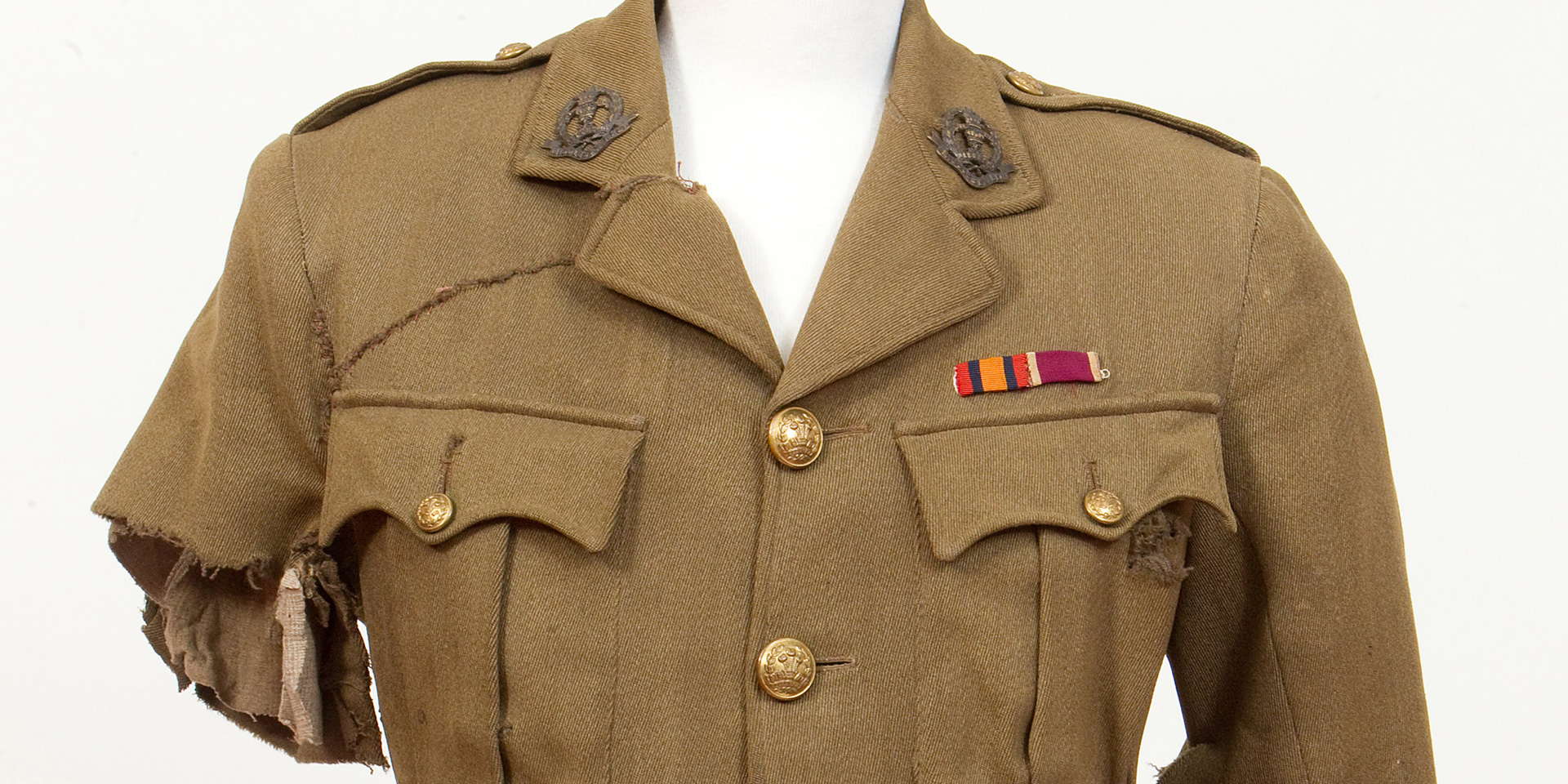Blood-stained and torn tunic of Fulham soldier to be displayed in Chelsea's National Army Museum
The battle-worn tunic of a local First World War soldier is to go on display in Chelsea's National Army Museum when it re-opens next year as a poignant reminder of the brutality of trench warfare - specifically the Battle of the Somme. The Museum also tells the story of Captain George Johnson on its First World War in Focus online portal.
Fulham-born Johnson was one of more than 57,000 British troops who were killed or injured on the first day of the Battle of the Somme during the First World War.
On 1 July 1916, 14 British divisions attacked at 7.30am, including Captain Johnson's Battalion - the 2nd Battalion The Duke of Cambridge's Own (Middlesex) Regiment. It followed a seven-day artillery bombardment of German trenches, which the allies believed would leave German defences exposed and in disarray, but actually caused little more than cosmetic damage.
Johnson's battalion's war diary sheds some light on the horrors faced by the troops when they found the enemy were ready for them, manning machine guns and protected behind barbed wire:
'As soon as our leading wave left our trenches to assist it was caught by heavy machine gun fire and suffered heavy losses. As soon as the succeeding eaves came under fire they doubled forward and before anyone reached the German front line the original wave formation had ceased to exist.'
The battalion was decimated during the attack, with only 51 of 673 men reaching the end of the day unharmed.
Captain George Johnson was one of the few men to actually make it across to the second line of the German trenches, but he suffered chest, pelvis and arm wounds in the process.
His uniform reflects the brutality of the injuries he sustained. There are large holes in the front and back where bullets and shrapnel penetrated and the sleeve of his tunic shows a visible rip where his uniform was cut away so medics could attend to his injuries.
Dr Peter Johnston, Collections Content Team Leader at the National Army Museum, commented:
'Captain Johnson's tunic is a poignant reminder of the bloodshed during the Battle of the Somme. In a war of millions, it's an important personal story and one we will explore when his tunic goes on display in the new museum next year.
'The tunic shows the wounds that affected Johnson for the rest of his life, and in a time of peace provides an insight into the horrors of the First World War. In many ways, objects like this are far better than words when it comes to trying to understand the experience of ordinary British soldiers in extraordinary times.'
While the war of attrition raged on with limited success until 18 November 1916, Johnson was evacuated home to St Thomas' Hospital in London on 3 July 1916. After lengthy rehabilitation, he was able to return to light duties, but he was continually troubled by his pelvic injury.
Many survivors from the Battle of the Somme were to face long-term injuries and health issues, and Johnson was no different. He underwent several operations to remove bone and bullet fractions from his old wound, until he was granted a war wound pension in 1917.
Captain Johnson later went on to return to his wife, Edith, in Fulham and had four children: Edith, Sydney, Victoria and Ivy. He worked for the Ministry of Pensions in Chelsea before retiring to Sudbury in 1944. He died in 1968 at the age of 90.
Such personal accounts are being unveiled each month in the Soldiers' Stories series, which helps to educate the public and share the best of the museum's assets while it is closed for refurbishment. They piece together the development of the war from the point of view of those directly involved - one hundred years from the time that they describe.
An interactive global map also features on the portal, which geo-tags all the major events of the war, as well as a timeline to help users piece together the development of the conflict and a host of learning tools. The website is a unique resource that will help commit the events of one hundred years ago to the country's national memory in one central place.
Notes for editors
For more information, please contact the National Army Museum press office at pr@nam.ac.uk or 020 7881 2433.
Captain George Johnson
George Johnson was born in Fulham, London, on 2 February 1878, to James (a bricklayer) and Catherine. One of eight children, George was educated at Fulham Board School, before enlisting for the army at the age of 18.
George married Edith Jane Mabel Gunter in 1899 - their four children, Edith, Sydney, Victoria and Ivy, were all born in military establishments at Hounslow, Mill Hill, Aldershot and Singapore.
During the Boer War (1899-1902), Johnson served with the 2nd Battalion The Duke of Cambridge’s Own (Middlesex Regiment), and the 4th Battalion at Woolwich. For his South African service, he received the Queen’s South Africa Medal with six clasps. He later served in both India and Singapore.
At the outbreak of war, Johnson was stationed in India, but he returned to England in 1914. After 18 years of service Johnson was commissioned as a second lieutenant in January 1915. He proceeded to France in February, where he re-joined his original battalion.
In September 1915, Johnson was made a lieutenant. His Battalion later moved to the Somme front, in March 1916, and spent several months there training and manning the trenches in the lead up to the battle. He was promoted to temporary captain in June 1916.
National Army Museum
The National Army Museum is the leading authority on the history of the British Army. Founded in 1960 by Royal Charter and established for the purpose of collecting, preserving and exhibiting objects and records relating to the Land Forces of the British Crown it is a museum that moves, inspires, challenges, educates and entertains. The Museum tells the story of the British Army, the personal experiences of the soldiers who have served and connects the British public and its Army demonstrating how the role of the Army and its actions are still relevant today.
Heritage Lottery Fund
Using money raised through the National Lottery, the Heritage Lottery Fund (HLF) aims to make a lasting difference for heritage, people and communities across the UK and help build a resilient heritage economy. HLF has supported 36,000 projects with £6bn across the UK.
For more information, please contact Katie Owen, HLF press office, on tel: (020) 7591 6036 out of hours mobile: 07973 613820.


